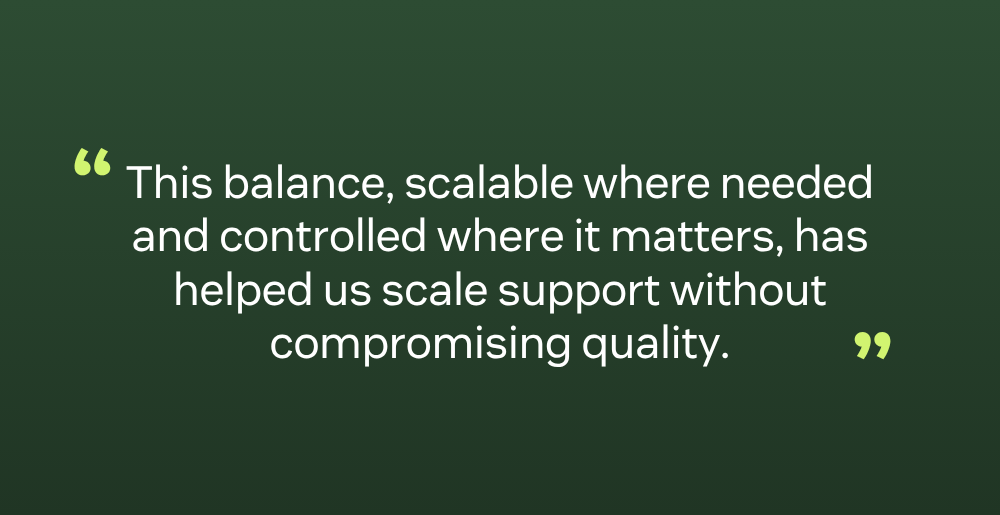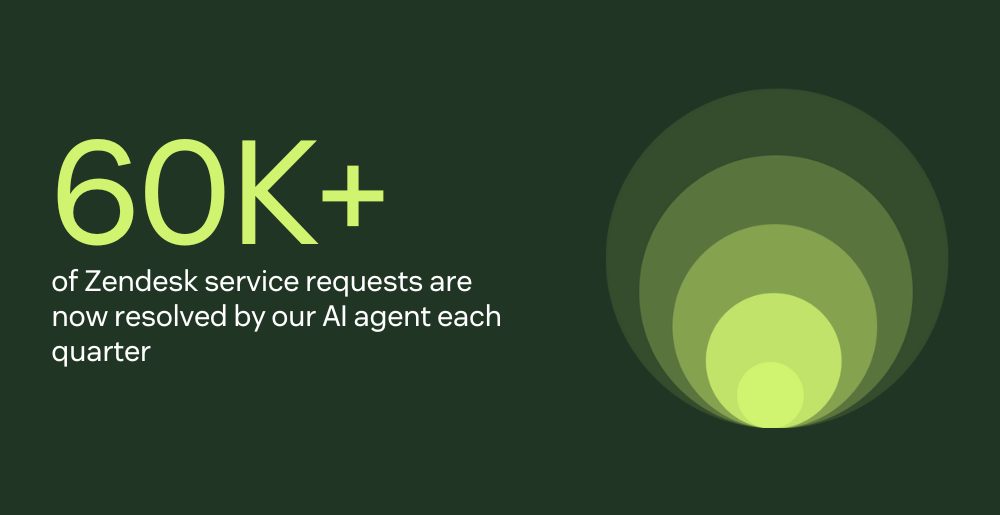Article • 6 min read
How Zendesk uses agentic AI to deliver instant, human-like support at scale
This is what it looks like when Zendesk AI supports Zendesk customers.
Austin Lacey
Director, Chatbots, AI & Automation at Zendesk
Zuletzt aktualisiert: July 22, 2025
We use what we build. Zendesk’s own support team runs on the same agentic AI and Resolution Platform we offer to customers. And it’s helping us deliver faster, more personalized support.
Each quarter, we resolve over 60,000 support requests with AI agents that carry out full workflows, execute backend actions, and adapt in real time to what our customers need. But they don’t work alone. These agents are part of our Zendesk Resolution Platform, where intelligence, orchestration, and automation come together to drive faster, smarter outcomes at scale.
This system has transformed how we work and helped our team refocus on what matters most: removing roadblocks, getting people unstuck, and delivering real resolutions. We’re here to share what it looks like to use agentic AI in practice—what’s changed, what we’ve learned, and where we’re headed next.
A turning point for AI-powered support
Zendesk has long used AI agents to provide 24/7 support, resolve customer issues, and free up our human agents to focus on sensitive, high-touch requests.
But as our business and product offerings grew, we started to see where traditional automation hit its limits. Multi-step, complex queries like updating in-product configurations still required human intervention, and we struggled to scale our AI agent to handle the wide variety of granular subtopics that our users raised.
That changed in March 2025, when we introduced a new generation of AI agents that redefined what we could trust AI to do on its own. Using agentic AI, these AI agents can reason through complexity, take secure action across systems, and resolve even the most complex requests all while staying grounded in our own business policies.
And we didn’t just ship these new capabilities to customers; we immediately activated them in our own support experience on day one.
Since then, agentic AI has powered a new level of automation across Zendesk support – helping us resolve more requests faster, without sacrificing quality or control.
Quick to implement, with powerful impact
One of the most immediate shifts we saw with agentic AI was how quickly we could start building and deploying automations. When hiring for our service team, we were able to rescope the skillset to deemphasize the need for deep workflow expertise. Why? Because we no longer needed it to get the job done.
Using our AI agent builder, we simply describe business procedures in natural language and the AI agent is ready to go. No flows, no code, no developer support needed.

We began by refining existing, lightweight tasks—like password resets—that were already handled by our AI agents. What truly stood out to our team was how quickly we could expand into more complex, nuanced workflows—like standing up entirely new channels, such as WhatsApp, for our customers. The process was fast and iterative, allowing us to scale support without disruption.
Starting small and building iteratively proved to be the most effective way to develop procedures. We began with a basic structure, layered in detail, and tested every one or two steps. This helped us move faster and avoid rework.
It didn’t take long to find our rhythm. As we continue to test and refine, we’re delivering reliable resolutions—even for edge-cases—without added complexity. We’ve been amazed at how quickly we can build high-quality, personalized responses that include specific docs or phrasing—all without having to script a single message.
More flexibility without losing control
One of the biggest advantages of agentic AI is that it lets us combine generative AI flexibility with structured control in a single resolution.
In our own support experience, we let Zendesk AI agents resolve freely using generative AI when flexibility is appropriate. For example, they generate answers to questions like how to troubleshoot a common error by using content from our help center and Zendesk.com – without scripting or training.
But some requests require precision. For those, we have the power to set explicit rules and workflows to guide the resolution. That includes high-stakes actions like:
- Enabling features like data exports—instantly and only for customers with the right permissions
- Activating international calling based on real-time eligibility and fraud-prevention signals
- Executing bulk user imports and trial extensions, with no human intervention required
And with 150+ customer datapoints pulled from backend systems at the start of each conversation, every interaction is infused with rich customer context to drive a cohesive, efficient experience. This balance—scalable where it needs to be, controlled where it matters—has helped us scale support without compromising quality or consistency.
Results that speak for themselves
By leveraging AI agents powered by agentic AI, we’ve seen massive results in both resolution quality and operational efficiency.
Here are the results we’ve seen across our own support operations:
- 60,000+ total service requests automated per quarter, driving exceptional CX at scale
- 2,000+ workflow-heavy service requests automated per quarter—with AI agents handling complex tasks that previously required human action
- 120% increase in high-quality generative responses, verified by QA
- Faster time-to-launch for new resolution flows, thanks to natural language procedures that anyone on the team can build and deploy
- Reduced reliance on intent-based flows, replacing them with smarter, more flexible agentic logic
- Rescoped skillsets for workflow heavy roles
- Expanding into use cases that were previously out of reach with traditional flows
Agentic AI has opened the door to use cases we simply couldn’t support before. What’s been most exciting is seeing how flexible and engaging these experiences can be – and how naturally the AI agent now adapts to each customer’s message. It’s a level of scalability we never would be able to achieve with traditional flows.

And we’re just getting started—because with agentic AI at the core of our support model, delivering faster, smarter, and more scalable service is no longer the goal—it’s the new standard.
What we’ve learned—and what comes next
Using agentic AI internally has transformed our operations, but it’s also changed how we think about support. We’re resolving faster, more intelligently, and with more control than ever before. This is clear across every metric that matters: higher-quality answers, faster outcomes, and a more seamless experience for our customers—and our teams.
We’re not slowing down. We’re already working to expand the use cases our AI agents can handle – and they don’t operate in isolation. We’re continuously advancing what AI can achieve across every layer of our Resolution Platform.
This includes the recent launch of generative search in our help center, which makes it easier for customers to surface answers by eliminating the need to dig through piles of articles. Innovations like these are indicative of our broader shift from reactive support to proactive, AI-powered resolution.
There’s more work to do. AI is evolving quickly and so are customer expectations. But we’re committed to learning, refining, and delivering better support by using the very tools we ask others to trust. And we’re building toward a future where every interaction is intelligent, every resolution is effortless – and AI is at the heart of how we serve.
That’s what it means to be both a builder and practitioner. And it’s how we plan to keep moving forward.
